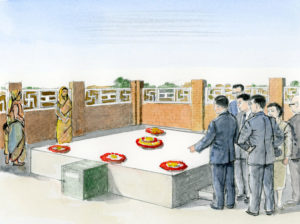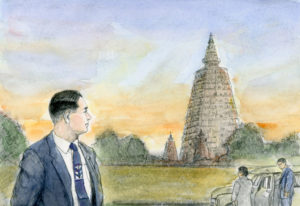Chapter Summary

Illustration courtesy of Seikyo Press.
After departing Hong Kong, Shin’ichi Yamamoto shared with his fellow leaders his plans to form a general chapter in Asia. Sensing everyone’s surprise, he said, “First, we have to create a vision and then think of how to go about realizing it” (The New Human Revolution, vol. 3, revised edition, p. 68). He wanted everyone to break free from the limitations of maintaining the status quo.
The group headed to Ceylon via Singapore. In Ceylon, where only two members lived, Shin’ichi encouraged a young man to become the district young men’s leader there.
On January 31, the group arrived in India. They toured the Qutb Minar, a tower erected by Qutb-ud-Din Aibak, founder of Muslim rule in India. They also visited Jama Masjid, a magnificent mosque in Old Delhi, and the Red Fort, an imperial palace.
At Raj Ghat, where Mahatma Gandhi was cremated, Shin’ichi reflected on Gandhi’s nonviolent struggle that led India to gain independence from British colonial rule. The group also visited the Firoz Shah Kotla Grounds to view a pillar inscribed with the Buddhist edicts of King Ashoka. There, they discussed the idea of governing the land based on Buddhist principles.
The group also visited the Taj Mahal and Agra Fort, and they arrived at Bodhgaya on February 4. To their relief, the custodial commission of Bodhgaya’s Mahabodhi Temple granted them permission to bury the items on the temple grounds. They conducted a ceremony to inter the stone plaque bearing the inscription “Kosen-rufu in Asia” and the airtight canister containing a copy of “On the Three Great Secret Laws,” among other items.
Shin’ichi deeply felt that he had taken his first step toward realizing the pledge he made to his mentor to accomplish kosen-rufu throughout Asia. And in India, the birthplace of Buddhism, he passionately called out in his heart: ‘Come forth, you Shin’ichi Yamamotos, in countless tens and hundreds of thousands!’” (NHR-3, revised edition, 139).
Unforgettable Scene

Illustration courtesy of Seikyo Press.
Come Forth, Tens of Thousands of Shin’ichi Yamamotos!
On February 4, 1961, Shin’ichi Yamamoto’s group held a ceremony to inter a stone plaque dedicated to kosenrufu in Asia and several other items at Bodhgaya, the sacred site of Shakyamuni’s enlightenment.
Recitation of the sutra resumed. After completing the verse portion of the “Life Span” chapter, they began chanting Nam-myoho-renge-kyo, their voices resounding sonorously through the Indian countryside. Shin’ichi Yamamoto offered his resolute pledge and deep prayer for the peace and happiness of the people of Asia …
A golden monument marking Buddhism’s future westward remigration had now been erected. Shin’ichi’s thoughts went to Josei Toda. His mentor’s poem echoed in his heart:
To the people of Asia,
who pray for a glimpse of the moon
through the parting clouds,
let us send them, instead,
the light of the sun.
As in the poem, the sun blazed in the sky, vividly illuminating the soaring tower of the Mahabodhi Temple. Shin’ichi had now taken his first step toward realizing the pledge he had made to his mentor to accomplish kosen-rufu throughout Asia. He had no way of knowing when that goal, when true peace and happiness, would be realized for the people of Asia and these commemorative items would be excavated. Nevertheless, responsibility for its accomplishment rested entirely on his shoulders.
“I’ll do it. I’ll do it no matter what,” he vowed. “If I fall along the way, I’ll entrust its completion to the youth, whom I consider extensions of my own being. ‘Come forth, you Shin’ichi Yamamotos, in countless tens and hundreds of thousands!’” Gazing up at the Indian sun, he made this passionate pledge in his heart. (NHR-3, revised edition, 138–39)
Key Passage
It may seem rather mundane, but I think that sincere, in-depth, face-to-face dialogue will ultimately lead to a correct perception and appraisal of the Soka Gakkai. (NHR-3, revised edition, 107)
You are reading {{ meterCount }} of {{ meterMax }} free premium articles

